Article contents
On Mutillidae parasitic on Glossina morsitans
Published online by Cambridge University Press: 10 July 2009
Extract
Mutilla glossinae, Turn.
Mutilla glossinae, Turner, Bull. Entom. Res., v., 1915, p. 383, ♀.
♂. Niger, albo-pilosus ; pronoto, mesonoto, scutelloque rufo-ferrugineis ; calcaribus albidis ; segmentis dorsalibus 2–4 apice anguste albo-fimbriatis ; alis basi hyalinis, dimidio apicali modice infuscatis ; mandibulis apice tridentatis. Long. 6 mm.
♂. Head narrower than the thorax, broader than long, rounded at the posterior angles, closely and not very finely punctured, the antennal tubercles well developed. Clypeus concave, smooth and shining. Third joint of the flagellum equal to the fourth, half as long again as the second and more than twice as long as the first. Eyes ovate, converging towards the clypeus, not emarginate ; ocelli placed in a triangle, the posterior pair a little further from each other than from the anterior ocellus and situated on the inner edge of a large but shallow depression. Thorax broad and short, closely but not coarsely punctured ; anterior margin of the pronotum straight, the posterior margin broadly arcuate ; scutellum flat, broadly truncate at the apex ; pleurae very closely punctured and sparsely clothed with long white pubescence. Median segment very coarsely reticulate, shorter than the scutellum, posterior slope very steep, not distinctly separated from the dorsal surface. Abdomen subsessile ; closely punctured, with distinct but narrow apical bands of long white hairs on segments 2–4, a less clearly defined band on the first ; apical dorsal segment broadly rounded, more coarsely punctured, the punctures more or less confluent longitudinally. Second ventral segment closely punctured and sparsely clothed with long whitish hairs, which form a continuous band on the apical margin. First dorsal segment short and broad, slightly depressed on the apical margin ; second very broad, fully twice as broad as long, the sides convex. Fore-wing with three cubital cells, radial cell very broad, not more than twice as long as broad ; first abscissa of the radius equal to the third, shorter than the second, the two recurrent nervures received near the middle of the second and third cubital cells.
- Type
- Original Articles
- Information
- Copyright
- Copyright © Cambridge University Press 1916
- 2
- Cited by


